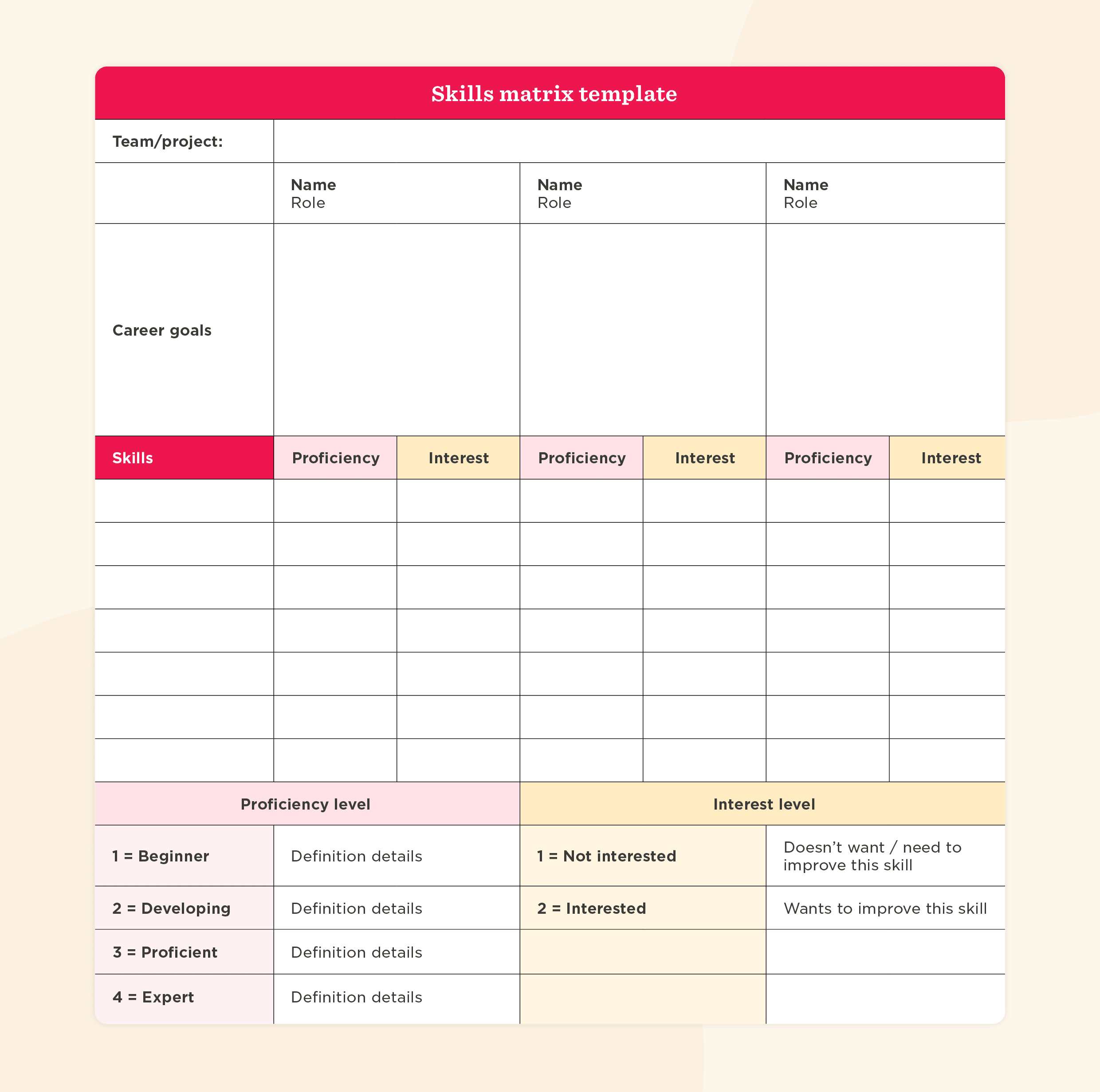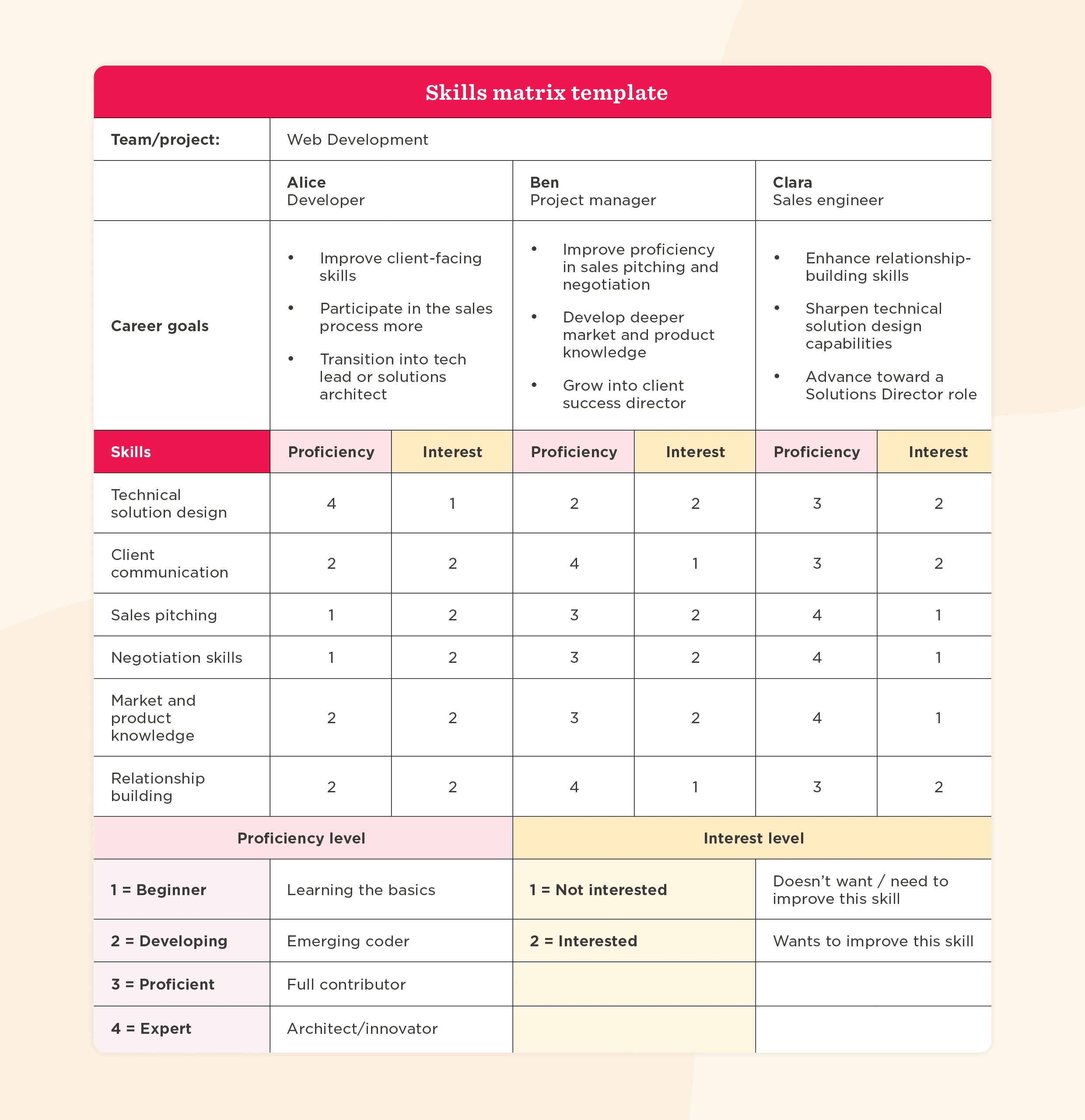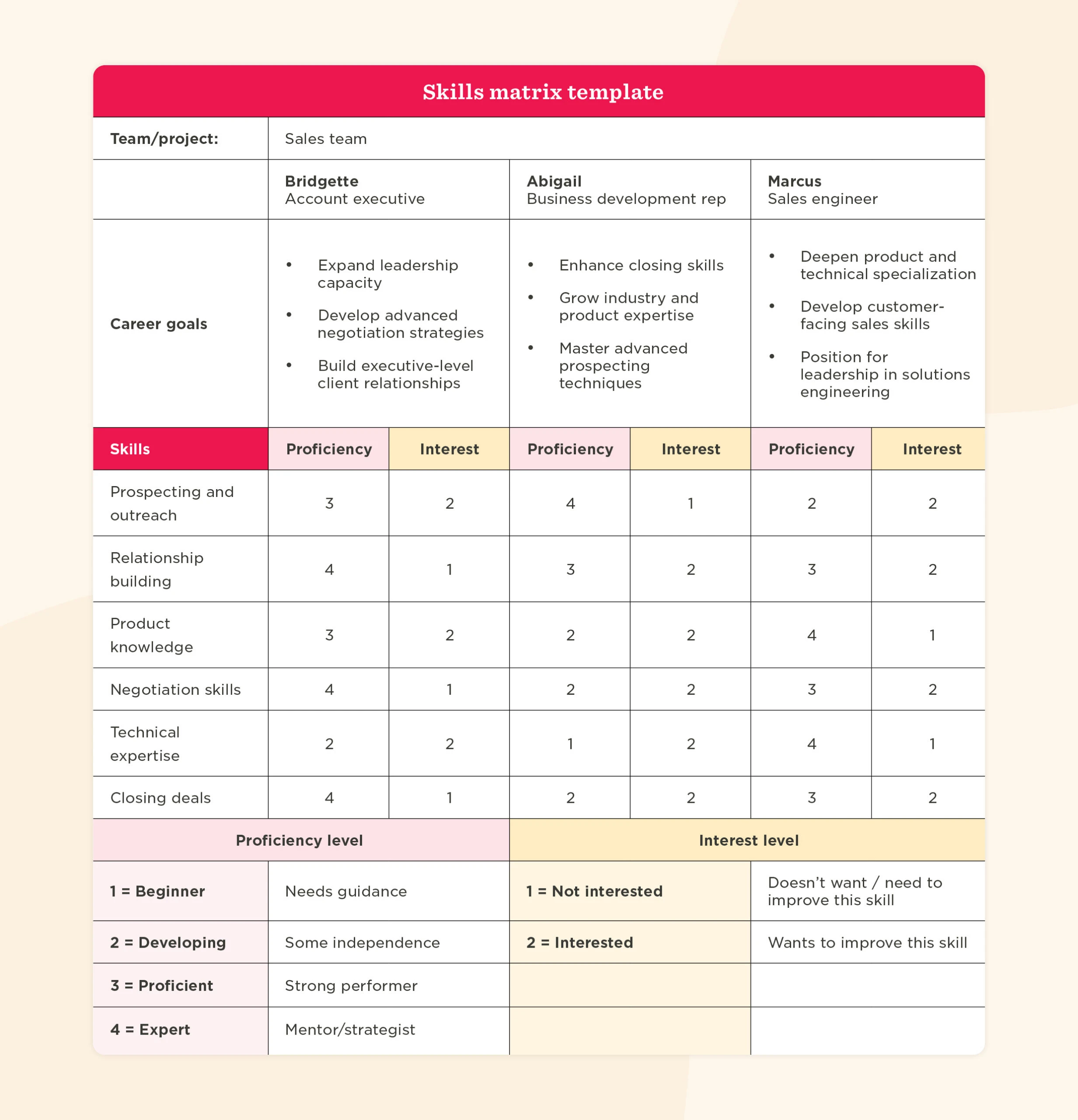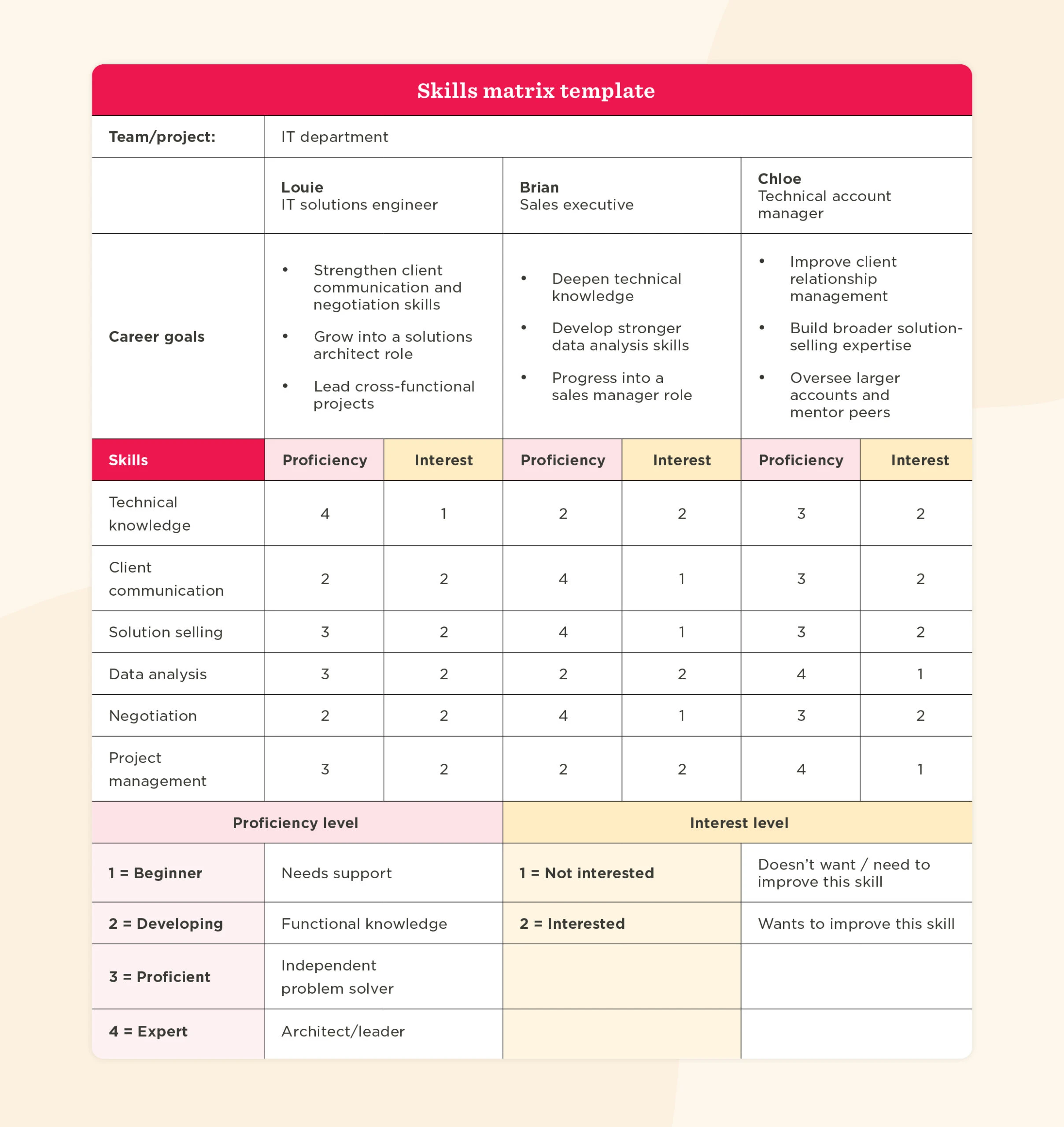Understanding your people’s capabilities gives HR professionals the insight to make smarter, more strategic development decisions. Whether you’re planning a complex project, reallocating resources, or stretching a tight learning budget, visibility into skills makes all the difference.
Strong workforce planning starts with knowing which skills you have now—and where your team is headed. In fact, 79 percent of people are open to sharing their skills data to help match them with the right work in the organization. This includes demonstrated capabilities, adjacent skills, and areas they want to develop.
With this data, HR teams can build effective development plans and align people strategy with business goals. A skills matrix template makes this easier. It’s a clear, structured way to map out team competencies, spot gaps, and drive decisions to align HR goals with business objectives.
In this guide, you’ll get practical steps to create and implement a skills matrix, plus a free downloadable template to get started right away.
<< Set your people and projects up for success with this free skills matrix template. >>
What is a skills matrix?
A skills matrix is a grid that tracks team members’ proficiency in the skills and competencies relevant to their roles. It lists each person alongside the key skills needed for job functions or projects, typically grouped into categories like technical and soft skills, and rated on a consistent scale.
This at-a-glance view helps HR teams assess current capabilities, spot skill gaps, and plan targeted development that aligns with business goals.
Why use a skills matrix in HR?
Skills matrices elevate people management by giving HR teams concrete data to guide strategic decisions. Instead of relying on assumptions or outdated job descriptions, you can align project and development plans with real competencies and current business needs.
American entrepreneur and former HR manager Jim Rohn put it best: “You should always start with where people are before you try to take them where you want them to go.”
With a skills matrix, HR teams can streamline key processes and drive improvements in:
- Workforce planning: Forecast future skill needs and spot potential leaders
- Targeted development: Build personalized continuous learning paths around individual strengths and gaps
- Project staffing: Match the right people to the right tasks based on verified skills
- Succession planning: Uncover leadership potential and address critical skill gaps
Free skills matrix template
This downloadable skills matrix template for Excel provides a ready-to-use framework HR teams can customize for specific organizational and departmental needs.
<< Set your people and projects up for success with this free skills matrix template. >>
Skills matrix examples
To help you visualize how a skills matrix works, here are a few examples to use for inspiration. Each example demonstrates how you can tailor the matrix to specific team functions while maintaining consistency in your assessment approach.
<< Set your people and projects up for success with this free skills matrix template. >>
Key components of a skills matrix
An effective skills matrix template includes several key elements that provide a comprehensive overview of team capabilities. The scope of your matrix is up to you—create a universal grid that covers entire departments or individual grids for each role within them.
To create a skills matrix template that suits your company’s needs, these are the essential components to consider:
- Skill categories: Organize competencies into categories that reflect both current role requirements and future business needs, such as technical skills, soft skills, and leadership abilities
- Proficiency scales: Use consistent measurement criteria that clearly define what each level means in practical terms
- Team member profiles: Include each person’s name, current role information, and career aspirations to contextualize skill assessments
- Gap indicators: Use visual cues like color-coding to highlight priority development areas
- Development plans: Attach development plans to your completed matrix to link each skills gap to specific learning opportunities and timelines
The proficiency scale serves as the measurement backbone of your skills matrix template. Whether you use numerical ratings, descriptive levels, or both, keep your ratings system consistent across all matrices so you can make meaningful comparisons and spot patterns faster.
Recommended For Further Reading
How to create a skills matrix for your HR team
Now that you know what a skills matrix template is and how it will benefit your people, it’s time to make your own. The following steps will help you build a top-notch skills matrix for your company’s needs.
1. Engage stakeholders
HR teams usually lead the process of creating skills matrices, but the real impact comes from how your people use them. Now is a good time to communicate the purpose and benefits of skills matrices to key stakeholders, such as project managers and team leads.
When you clearly show how a skills matrix supports smarter resource allocation, succession planning, and career development, it’s easier to gain buy-in across the business. Highlighting the personal benefits—like uncovering hidden strengths and creating new growth opportunities—can also help reduce resistance and encourage adoption.
Pro tip: Don’t just introduce the skills matrix—run a short walkthrough session with team leads to show them how to use it in real scenarios, like planning project teams or identifying stretch opportunities. This helps turn a static document into a living tool for decision-making and development.
2. Identify core HR competencies
Complete a thorough analysis of your HR team’s current and future skill requirements. “You can’t act on something if you don’t have the knowledge,” says Salome Jansen Van Vuuren, senior solutions architect at SHL, a workforce data insights provider. “Understanding that internal screenshot allows you to plan, from a talent acquisition perspective, where those gaps are, and how you fill them.”
Review job descriptions and past performance review notes, touch base with team members about their daily responsibilities, and consult with department managers about evolving HR needs to create a comprehensive competency list. Focus on primary requirements—skills that directly impact team performance and business outcomes—rather than trying to capture every possible competency.
Pro tip: Highlight specific competencies that support career progression within your company. This forward-looking approach helps team members understand which skills to develop for advancement opportunities.
3. Balance soft and hard skill assessment
While hard skills demonstrate your ability to perform job-related tasks, soft skills show how you approach your work and interact with others. In many cases, soft skills determine how effectively you apply hard skills in practice.
For example, an engineer may have top-level coding expertise but need help with their collaboration and problem-solving skills to contribute more effectively in cross-functional teams. Balancing both skill types in your matrix ensures you can spot gaps in team dynamics quickly and design better training programs.
Pro tip: Since different roles benefit from different soft skills, consider creating a core set of soft skills for everyone and sets of role-specific add-ons. A customer-facing role’s add-ons might include empathy and active listening, whereas a technical lead would benefit more from strategic thinking and stakeholder communication skills.
4. Define proficiency scales
Choose your skill proficiency levels and create clear, specific descriptions for each level to prevent ambiguity in assessments. Consider using a four-point scale to avoid the tendency to select middle ratings, such as:
- 1 = Beginner
- 2 = Developing
- 3 = Proficient
- 4 = Expert
Proficiency levels can be customized to provide role-specific clarity while staying consistent in format. Take this sales team proficiency scale as an example:
1 = Beginner
- Understands basic sales concepts but lacks confidence in execution
- Relies heavily on scripts, checklists, or coaching
- Struggles to handle objections or close deals without help
2 = Developing
- Can manage the sales process in straightforward situations
- Demonstrates growing product knowledge and rapport-building skills
- Handles common objections but may lose momentum in complex deals
3 = Proficient
- Manages the full sales cycle independently
- Adapts communication style effectively for different prospects
- Consistently hits or exceeds targets and maintains a healthy pipeline
4 = Expert
- Acts as trusted advisor for clients and excels in complex negotiations
- Coaches others on sales techniques and best practices
- Shapes sales strategy and identifies opportunities for process improvement
A direct approach forces more decisive assessments and provides clearer direction for development planning. “When you can get to that level of detail, you can get much more targeted in your recruitment, in your internal mobility of talent, and applying the right talent to the right tasks and projects, and thereby also accelerate business performance,” explains Patrick Hull, vice president of future of work at Unilever.
Pro tip: Keep proficiency level descriptions behavior-based and measurable. This ensures consistent evaluations across managers and helps team members understand exactly what they need to grow.
5. Rate current team members
Once your proficiency scale is on lock, the next step is to rate your people’s current skill sets and fill out your skill matrix template. Gather multi-source feedback that combines self-evaluation, manager assessments, and team input where appropriate for a more accurate and complete picture of each person’s capabilities.
Another way to encourage accurate ratings is to schedule individual chats with each team member to review their self-assessments and gather context about their development interests—maybe even give them a career path template. These conversations often reveal skills that might not be apparent in day-to-day work but could be valuable for future projects or roles.
“You want to make sure you have the right people in the role,” says Ann Wang, director of human resources for the Solar Energy Industries Association in Washington, DC. Keeping tabs “will help you know if your organization and the roles are moving in the right direction, and if any tweaks need to be made.”
Pro tip: After initial assessments, bring managers together to compare how they’ve applied proficiency levels. Use this time to spot inconsistencies, align on standards, and ensure fair, accurate ratings across teams—especially for cross-functional roles.
6. Identify gaps and plan learning and development
Analyze your completed matrix to identify patterns in skill gaps across the team and prioritize development initiatives based on business impact and individual career goals. Look for both individual development needs and team-wide capability gaps that might require different intervention strategies.
As you assess your skills matrix data, take into consideration:
- Short-term needs: Address immediate performance gaps that impact current productivity
- Long-term capabilities: Build skills that support succession planning and company growth
- Individual preferences: Align development opportunities with personal career interests
- Business priorities: Focus resources on skills that drive strategic objectives
Then, create specific development plans that connect identified gaps to concrete learning opportunities, whether through formal training, stretch assignments, or mentoring relationships.
Pro tip: Use your business roadmap to triage skill gaps. Not every gap needs immediate action—prioritize those tied to upcoming initiatives, product launches, or strategic shifts. This ensures your development efforts stay focused and high-impact.
7. Update and maintain the matrix
Establish a regular review cycle that keeps your skills matrix template current and relevant to changing business needs. “You cannot be satisfied with ‘one and done,’” says Anna Langford, president of Langford Top Ten Consulting in Louisville, Kentucky. “You need to make sure you have an ongoing strategy to maintain this process.”
Quarterly reviews work well for most teams, allowing enough time for skill development while maintaining momentum around growth initiatives. Track changes over time to measure the effectiveness of your development efforts and identify trends that might inform future training investments or hiring decisions.
Pro tip: Assign ownership of the matrix to a specific team lead or HR partner. This helps keep updates on track and ensures accountability for integrating the matrix into workforce planning conversations.
Empower your HR team with a skills matrix template
A well-implemented skills matrix provides HR teams with a solid foundation from which to build stronger, more capable teams. When you know the exact makeup of your team’s skill sets and interests, it allows you to pinpoint which development opportunities will have the greatest impact, resulting in more strategic investments in your people.
Using a skills matrix template as your jumping-off point means you can get started right away without the friction of building new processes from scratch. Save time and ensure consistency across teams and departments with pre-designed rows and columns that can be customized easily and filled out quickly.
<< Set your people and projects up for success with this free skills matrix template. >>
Skills matrix FAQs
What skills are in a skills matrix?
The skills featured in a skills matrix vary depending on the industry, roles, and job-specific functions being monitored, but they typically fall under three core categories:
- Technical skills: Software proficiency, coding languages, data analysis
- Soft skills: Communication, conflict resolution, emotional intelligence, critical thinking
- Leadership skills: Strategic planning, change management, decision-making
The matrix also tracks people’s interest in learning new skills and the learning and development needed to help them upgrade their skill set.
What are the 4 quadrants of the skill matrix?
The four quadrants of the skill matrix (also known as the skill/will matrix) divide team members into categories based on their skill and will (or motivation) to perform a task. These quadrants are defined as follows:
- High proficiency/high interest: Future leaders who thrive in their current positions and show potential for growth
- High proficiency/low interest: Reliable specialists who deliver consistently but may have reached a growth plateau
- Low proficiency/high interest: Developing talent who need targeted coaching to unlock their full potential
- Low proficiency/low interest: Team members who require performance improvement plans or role reassessment
Using a four-quadrant approach helps HR teams understand where each team member’s capabilities and drive land. This allows them to implement a tailored performance management strategy so everyone receives the level of support they need and deserve.
How often should I update a skills matrix?
For maximum effectiveness, aim to update your skills matrix every few months, depending on the pace of change within your company. The key is to establish a consistent schedule that integrates with your existing performance management processes.
Regular updates will help you capture recent skill development, maintain momentum on growth initiatives, and stay on top of shifts in organizational goals.




